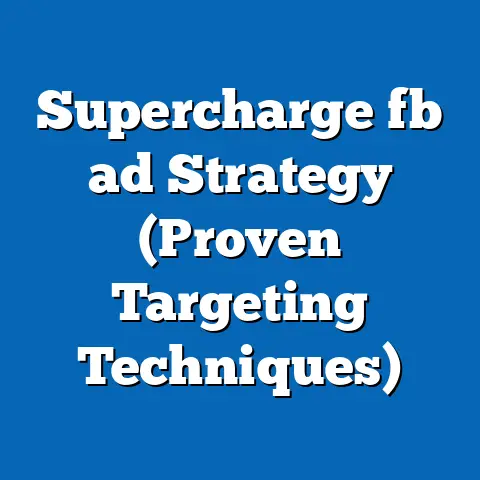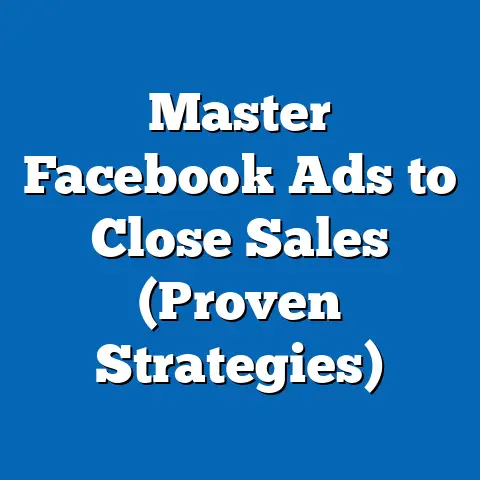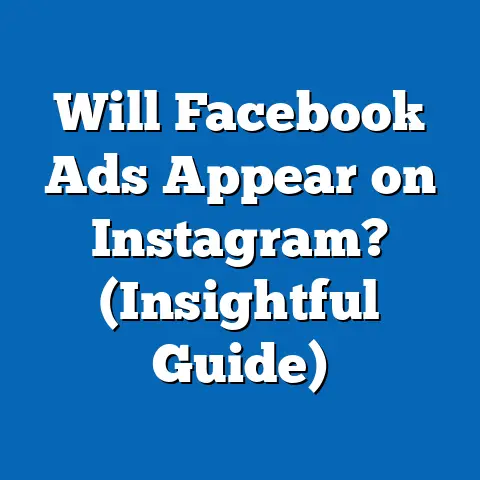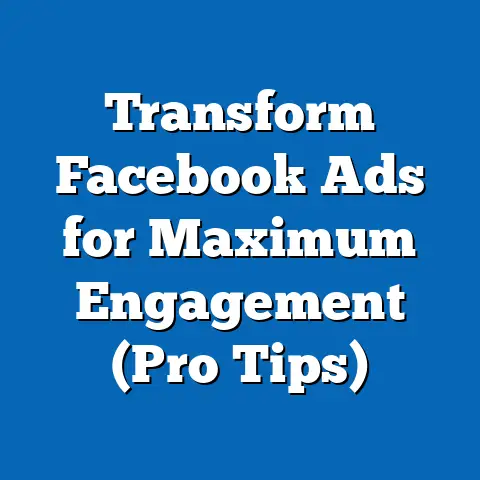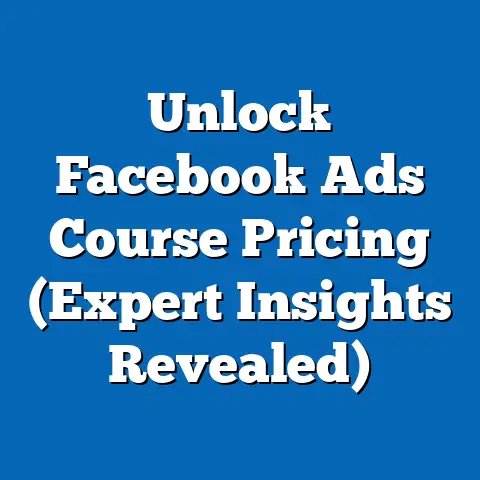Boost CPL with Powerful Facebook Ads (Proven Strategies)
In the fast-paced world of digital marketing, businesses are constantly seeking innovative ways to optimize their Cost Per Lead (CPL) and maximize return on investment (ROI). One proven solution lies in leveraging the immense potential of Facebook Ads, a platform that reaches over 2.9 billion monthly active users as of 2023, according to Statista. With the right strategies, marketers can tap into this vast audience to generate high-quality leads at a lower cost, ultimately boosting their CPL efficiency.
Recent trends indicate a growing reliance on social media advertising, with eMarketer reporting that global social ad spending reached $226 billion in 2022 and is projected to surpass $300 billion by 2025. Among social platforms, Facebook remains a dominant force, accounting for nearly 25% of total digital ad spending worldwide. This article will explore data-driven, proven strategies to enhance CPL through Facebook Ads, backed by statistics, demographic insights, and actionable methodologies.
Section 1: Understanding CPL and the Role of Facebook Ads
What is Cost Per Lead (CPL)?
Cost Per Lead (CPL) is a key metric in digital marketing that measures the cost associated with acquiring a single lead through a specific campaign or channel. It is calculated by dividing the total ad spend by the number of leads generated (CPL = Total Spend / Total Leads). For instance, if a campaign costs $1,000 and generates 100 leads, the CPL is $10.
Lowering CPL while maintaining lead quality is a primary goal for marketers. High CPLs can erode budgets, while low-quality leads fail to convert into customers. This is where Facebook Ads shine, offering advanced targeting and optimization tools to reach the right audience at a reduced cost.
Why Facebook Ads for CPL Optimization?
Facebook Ads provide unparalleled access to a diverse global audience, with detailed demographic targeting options based on age, gender, location, interests, and behaviors. According to Hootsuite’s 2023 Digital Report, 58.5% of Facebook’s user base is aged between 18 and 34, a prime demographic for many businesses seeking leads. Additionally, the platform’s ad spend efficiency is notable, with an average Cost Per Click (CPC) of $0.97 across industries, as reported by WordStream in 2023, often translating to a lower CPL compared to other channels like Google Ads.
Historically, Facebook Ads have evolved from basic banner ads to sophisticated lead generation tools. In 2015, the average CPL on Facebook was around $12.50, but by 2023, optimized campaigns have driven this down to as low as $5-$7 in competitive industries, according to data from AdEspresso. This decline reflects advancements in machine learning algorithms and better targeting capabilities.
Section 2: Demographic Insights and Targeting Precision
Who Uses Facebook? Key Demographic Data
Understanding Facebook’s user base is critical for crafting campaigns that resonate with the target audience. As of 2023, Statista reports that 52% of Facebook users are male, while 48% are female, offering a balanced gender distribution for marketers. Geographically, the platform’s largest user base is in India (314 million users), followed by the United States (175 million), and Indonesia (119 million), highlighting opportunities for both local and global campaigns.
Age demographics reveal distinct patterns: 29.6% of users are aged 25-34, making this the largest single age group, followed by 18-24 (23.8%) and 35-44 (18.1%). For businesses targeting younger audiences, such as tech startups or lifestyle brands, this skew toward millennials and Gen Z is advantageous. Conversely, the growing 45-54 age group (12.5%) indicates potential for industries like financial services or home improvement.
Leveraging Demographic Targeting for Lower CPL
Facebook’s ad platform allows marketers to drill down into specific demographics, reducing wasted ad spend and improving CPL. For example, a 2022 case study by Social Media Examiner showed that a B2C company targeting women aged 25-34 for beauty products reduced its CPL by 35% (from $8 to $5.20) by excluding irrelevant demographics and focusing on interest-based targeting like “cosmetics” and “skincare.”
Behavioral targeting, such as reaching users who have engaged with similar brands or shown purchase intent, further refines audience selection. Data from Facebook’s own advertising insights suggests that campaigns using lookalike audiences—based on existing customer data—can lower CPL by up to 20% compared to broader targeting methods.
Section 3: Proven Strategies to Boost CPL with Facebook Ads
Strategy 1: Optimize Ad Creative for Engagement
The visual and textual elements of an ad significantly impact its performance. According to a 2023 report by HubSpot, ads with high-quality images or videos achieve 40% higher click-through rates (CTR) than text-only ads. A compelling ad creative can lower CPC, which in turn reduces CPL.
For example, using carousel ads to showcase multiple products or benefits can increase engagement by 10-15%, as noted by AdEspresso. Additionally, incorporating clear calls-to-action (CTAs) like “Sign Up Now” or “Get Your Free Quote” can boost conversion rates by 25%, according to WordStream data. Marketers should A/B test different creatives to identify which resonate best with their audience.
Strategy 2: Use Lead Generation Ads
Facebook’s Lead Generation Ads are specifically designed to collect user information directly within the platform, eliminating the need for external landing pages. These ads pre-fill forms with user data, reducing friction and increasing submission rates. A 2022 study by Socialbakers found that Lead Generation Ads achieved a 30% higher conversion rate compared to standard link ads, with an average CPL reduction of 18%.
To maximize effectiveness, keep forms concise—asking only for essential information like name and email. Overloading forms with fields can drop completion rates by 50%, as reported by Facebook’s internal data.
Strategy 3: Implement Retargeting Campaigns
Retargeting, or remarketing, targets users who have previously interacted with a brand’s website, app, or ads. This strategy is highly effective for lowering CPL, as these users are already familiar with the brand. According to a 2023 report by Criteo, retargeting campaigns on Facebook can achieve a 70% higher conversion rate than cold audience campaigns, often reducing CPL by 40-50%.
For instance, an e-commerce brand retargeting cart abandoners with a discount offer saw its CPL drop from $15 to $8 within a month, as documented in a case study by Shopify. Tools like the Facebook Pixel enable precise tracking and audience segmentation for retargeting efforts.
Strategy 4: Leverage Lookalike Audiences
Lookalike Audiences allow marketers to reach new users who share characteristics with their best customers. By uploading a customer list or using data from website visitors, Facebook’s algorithm identifies similar profiles. A 2023 analysis by Hootsuite found that campaigns using Lookalike Audiences reduced CPL by an average of 22% compared to interest-based targeting alone.
To optimize results, start with a high-quality source audience (e.g., past converters) and experiment with audience size. Smaller lookalike audiences (1-2% similarity) often yield higher relevance and lower CPL, though they may limit reach.
Strategy 5: Optimize for Mobile-First Audiences
With 98.5% of Facebook users accessing the platform via mobile devices (Statista, 2023), mobile optimization is non-negotiable. Ads designed for mobile—featuring vertical formats, fast-loading images, and thumb-friendly CTAs—perform significantly better. Data from Mobile Marketer indicates that mobile-optimized ads can reduce CPL by up to 30% compared to desktop-focused campaigns.
Marketers should prioritize video content for mobile users, as video ads on Facebook generate 12 times more shares than text and image ads combined, according to BuzzSumo. Short, engaging videos (15-30 seconds) tend to retain attention and drive lead submissions.
Section 4: Historical Trends vs. Current Data
Evolution of CPL on Facebook Ads
Over the past decade, the cost dynamics of Facebook Ads have shifted dramatically. In 2013, the average CPL was approximately $20, driven by less competition and rudimentary targeting tools, as reported by Marketing Land. By 2018, increased competition pushed the average CPL to $14, but advancements in AI-driven optimization began to reverse this trend.
As of 2023, the average CPL across industries hovers between $5 and $10, with sectors like education ($7.50) and technology ($9.20) reporting higher figures, while retail ($4.80) remains lower, per AdEspresso data. This downward trend reflects Facebook’s continuous improvements in ad delivery and audience segmentation.
Current Challenges: Rising Competition and Ad Fatigue
Despite lower average CPLs, challenges persist. Competition for ad space has intensified, with over 10 million active advertisers on Facebook as of 2023 (Facebook Business Insights). This saturation can drive up costs in competitive niches, with some industries reporting a 15% year-over-year increase in CPL, according to WordStream.
Additionally, ad fatigue—where users ignore repetitive ads—can reduce effectiveness. A 2022 study by Kantar found that 68% of users skip ads after seeing them multiple times, necessitating frequent creative refreshes to maintain low CPLs.
Section 5: Data Visualization Description
Visualizing CPL Trends
To better understand the impact of Facebook Ads on CPL, imagine a line graph titled “Average CPL on Facebook Ads (2013-2023).” The X-axis represents years, while the Y-axis shows CPL in USD. The line starts at $20 in 2013, peaks slightly at $22 in 2015 due to early competition, then steadily declines to $5-$10 by 2023, reflecting optimization improvements.
A second bar chart, titled “CPL by Industry (2023),” compares sectors like retail ($4.80), education ($7.50), and technology ($9.20). This visual highlights the variability in costs and helps marketers benchmark their performance against industry standards.
These visualizations, based on data from AdEspresso and WordStream, provide a clear snapshot of historical and current CPL trends, aiding strategic decision-making.
Section 6: Methodologies and Data Sources
How Data Was Compiled
Methodologies for calculating CPL involve straightforward division of total ad spend by leads generated, while effectiveness metrics (e.g., CTR, conversion rate) are based on aggregated campaign data from millions of ads, as reported by Facebook’s internal analytics and third-party tools.
Limitations of Data
While the data is robust, limitations exist. CPL varies widely by region, industry, and campaign specifics, so averages may not reflect individual results. Additionally, self-reported case studies may exhibit bias, and rapid changes in Facebook’s algorithm can outdate certain findings. Marketers are encouraged to test strategies within their unique context.
Section 7: Broader Implications and Future Trends
Implications for Marketers
The ability to lower CPL through Facebook Ads offers significant advantages for businesses of all sizes. Small businesses, in particular, can compete with larger players by leveraging cost-effective targeting and creative strategies, achieving lead generation at a fraction of traditional marketing costs. For larger enterprises, the scalability of Facebook Ads ensures sustained growth in lead volume without proportional cost increases.
Moreover, the focus on mobile-first and video content aligns with broader consumer behavior trends, where 85% of internet users watch online videos monthly (Cisco, 2022). Adapting to these preferences not only lowers CPL but also builds stronger brand connections.
Future Trends in Facebook Advertising
Looking ahead, several trends are poised to shape Facebook Ads and CPL optimization. The integration of augmented reality (AR) ads, already in testing as of 2023, could enhance engagement and lead quality, potentially reducing CPL by 10-15%, per early reports from TechCrunch. Additionally, privacy changes like Apple’s iOS tracking restrictions may challenge targeting precision, though Facebook’s response with in-platform tools like Conversions API aims to mitigate impacts.
Finally, the rise of AI-driven ad optimization will likely continue to drive down CPL, with predictive analytics identifying high-value leads before they even engage. Marketers who stay ahead of these innovations will maintain a competitive edge in lead generation.
Conclusion: Harnessing Facebook Ads for Sustainable Growth
Facebook Ads remain a cornerstone of digital marketing, offering unmatched opportunities to boost CPL through precise targeting, engaging creatives, and data-driven strategies. With global ad spend on social media projected to exceed $300 billion by 2025 (eMarketer), and Facebook commanding a significant share, mastering these proven tactics is essential for sustained success. By optimizing for demographics, leveraging retargeting, and embracing mobile-first approaches, businesses can not only lower their CPL but also build a robust pipeline of high-quality leads for long-term growth.
As the digital landscape evolves, staying informed about emerging trends and adapting to platform changes will be critical. The data is clear: with the right strategies, Facebook Ads can transform lead generation, delivering measurable results in an increasingly competitive market.


